| Informational Websites | ChronoMaddox -- the legacy of Chuck Maddox | OnTheDash -- vintage Heuer website | Zowie -- Omega information |
| Discussion Forums | ChronoMaddox Forum | Heuer Forum | Omega Forum |
| Counterfeit Watchers | ChronoTools Forum | ChronoTrader Forum |
|
|
The largest independent, non-commercial, consumer-oriented resource on the Internet for owners, collectors and enthusiasts of fine wristwatches. Online since 1998. | |||||||
|
||||||||
|
||||||||
 |
Vintage Heuer Discussion Forum
The place for discussing 1930-1985 Heuer wristwatches, chronographs and dash-mounted timepieces. Online since May 2003. | ||||||
| |||||||
| |||||||
I’ve posted some of this before, but having talked about understanding reference numbers again a couple of times recently, I thought it might be worth reiterating some of the points again.
Heuer stopwatches had long had a numbering schema that related to various elementals of the case, dial and internals but the references for the chronographs yielded less information. Not that I’ve ever sat down to interpret the stopwatch references….
The 40s
1940s references are often sequential, e.g. 5410, 5411, 5412 but there are often gaps in the sequences that I haven’t been able to get to the bottom of. These sequences aren't always linear either - a 2447 precedes a 2444, for example. We do see some traits that are familiar from later watches though, such as a different case material for the same watch receiving a different reference number and the use of alpha suffices showing some familiar indicators – N for a black dial, T for a tachy scale etc. We also see a couple of references that, confusingly, would also be used later for Carrera 12s – 2447 and 2456. Another series running 402, 403, 406 would also have echoes in another ‘60s watch, the 404.
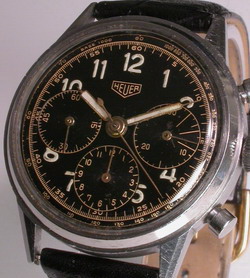
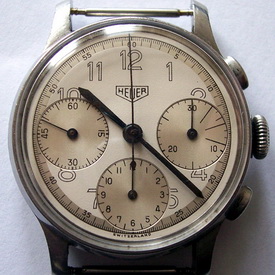
Some references in the 40s are 3-digit, others have 4. We start seeing some trends here that continue through to the 60s too – where a 4-digit reference is used, a watch with a 2xxx reference has 3 registers, whereas one with a 3xxx reference has 2. I don’t know how this inversion came about, it would be easier to grasp if reversed, but does hold true for quite a lot of Heuer watches for 3 decades, all the way up to Carreras and Autavias etc in the 60s.
The 60s
By the time the Carrera is launched in 1964, Heuer has settled on a 4 digit numbering scheme, with the 404 series of watches having been dropped in favour of the rapidly successful new watch. We still can’t interpret much from the references in this period, other than the number of registers from the first digit, but at the end of the decade that was to change. The last two digits also often remain the same within a series of watches, e.g. a 2447 and 3647 are both Carreras.
The alpha suffices were still being used at this point. Silver or white dials were being described as “standard” in some Heuer brochures by now, so for watches with a scale the silver dial was taken as read. A 3647 T then is a Carrera 45 with tachy scale on a silver/white dial, whereas for a watch with a scale and a black dial, the suffix had to draw attention to the dial too – the black dialled equivalent here is a 3647 NT. The watches at this point either had contrast registers (Autavia) or didn’t (Carrera), so the suffix didn’t have to take this into account.
/Carrera_45/c.Reference_3647_T.jpg)
/Carrera_45/e.Reference_3647_NT.jpg)
The suffix for the Autavias on the other hand didn’t relate to the dial at all, but rather which external bezel was supplied with the watch (e.g. the H on a 2446 H indicating that the bezel was marked with hourly divisions 1-12, though the 12 is in fact a triangle).
/Reference_2446_(Three_Register).jpg)
/Reference_3646_(Two_Register).jpg)
Common suffices used at the time included:
S – “standard” dial, in silver or white
N – black dial
T – standard dial with tachymetre scale OR Autavia with external Tachy bezel
NT – black dial with tachymetre scale
D – standard dial with decimal scale
P – standard dial with pulsometer scale
M – Autavia with external bezel divided into minutes
H – Autavia with external bezel divided into hours
MH – Autavia with external bezel marked with both minutes and hours
GMT – Autavia with external bezel marked with 24 hours and additional hand for calculating the time in a second time zone
Towards the end of the decade, this was further complicated by the introduction of Carreras with contrasting registers. The format for this becomes to have the colour of the dial indicated first, followed by the colour of the registers and finally to indicate any scale that is present. NST therefore would be a watch with a black dial, white registers and a tachy scale.
/Carrera_12/j.Reference_2447NST_(Tachy_B-W).jpg)
The early 70s
With the launch of the watches powered by the Valjoux 7730 at the end of the 60s, we see a numbering scheme beginning to come into use that all the watches are conforming to. These reference numbers give us information on the movement used in a watch, the series it comes from (e.g. Carrera, Monaco etc) and the case material. Prior to this point, Heuer was engraving the serial number on their watches but now with the introduction of this universal numbering scheme, they also engrave the model reference too.
By the time the automatics are launched shortly afterwards, this standard numbering scheme is firmly in place. It conforms to the following format:
XXYZ
Where X is the movement, Y is the model range and Z is the case material. The suffix letters again indicate the dial colour, although contrast registers have now become more of a norm.
The movement digits XX can have the following values:
77 – Valjoux 7730
78 – Valjoux 7734
11 – Heuer Calibre 11 or 12 depending on the age of the watch. Reference numbers were not changed with the adoption of the 12 replacing the 11.
15 – Heuer Calibre 15
The model digit Y can have the following values:
2 – economy series 2
3 – Monaco
4 – Camaro
5 – Carrera
6 – Autavia
7 – economy series 3
The case material digit Z can have the following values:
1 – black PVD
3 – steel
5 – 16K 20 micron gold-plate
8 – 18K gold
So an 1158 is a Calibre 11/12 Carrera in an 18K gold case, a 1563 is a Calibre 15 Autavia in a steel case etc.
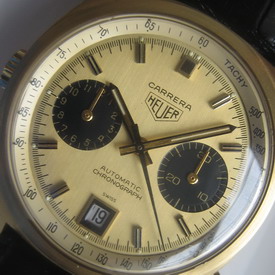

The Camaro models 9220, 7220 and 7228 partially conform to this standard by adopting the movement reference digits, though precede the full schema being used. Also, the Camaro was not introduced in an automatic version so the schema only applies to the last versions of the Camaro manuals.
The limitations of this 4 digit schema became clear when further manual versions of some of the automatic watches were introduced, using a wider variety of movements from the Valjoux 773x family. To this end, the schema was amended to accommodate this for the manual watches only as follows:
XXXYZ
Where all the letters have the same meaning as in the 4 digit schema but the movement digits are expanded to allow 3 different movements to be indicated:
733 – Valjoux 7733, two registers
734 – Valjoux 7734, two registers with date
736 – Valjoux 7736, three registers
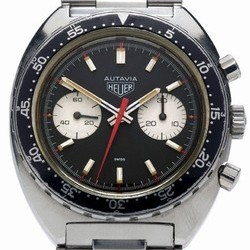
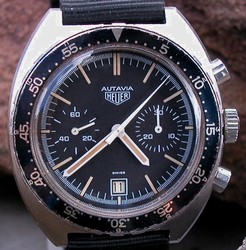
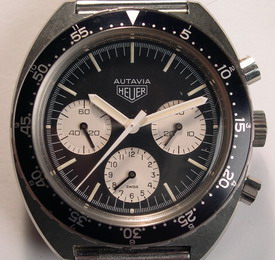
Many of the suffices are familiar from the 60s ones above, but it is worth noting what they refer to can differ both by series and model of watch, e.g. a B suffix on a Monaco and a Carrera does not always mean that both are the same colour of blue. Carreras now routinely come with an internal tachy bezel so this is no longer reflected in the suffix. Decimal and pulsometer bezels seem to have been available to special order; again this does not appear to have been shown in the suffix. As stated earlier, contrast registers had now become the norm and are assumed in most of the suffices although there are some exceptions noted below:
MH – Autavia with external bezel marked with both minutes and hours
GMT – Autavia with external bezel marked with 24 hours and additional hand for calculating the time in a second time zone
T –Autavia with external tachy bezel
S – silver dial with black registers
S – on Carreras 1158 S and 73655 S a silver dial with silver registers
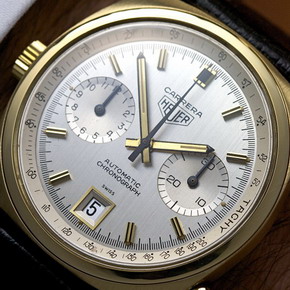
N – charcoal dial with white registers on Carreras; later dark blue and white
N – black dial with white registers on Autavias
B – blue dial with white registers on Monacos; does not indicate the more metallic finish of a transitional compared to the flatter finish of series production models
G – grey dial with either grey or black registers on Monacos
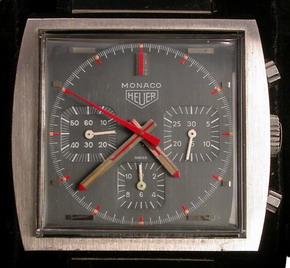
.jpg)
CH – champagne dial with champagne registers on Carreras and Camaros
CHN – champagne dial with black registers on Carreras and Camaros
The mid-70s
At the time they introduced the schema, Heuer probably thought they had something that was fairly future-proof and would carry them forward for quite some time. They had, after all, given themselves a fair degree of flexibility to differentiate within it – 10 discrete series of watch models was more than they had ever had, and more than they would ever need surely?
However, they clearly didn’t anticipate how the model range would explode during the 70s even when making this decision at the end of the 60s, which is pretty interesting in itself.
Cracks were already showing in the 4 & 5 digit numbering schemes by 1972, with the need to differentiate between Autavia cases necessitating the addition of a 0 to make the 11630 reference. This is still readable using the schema if you ignore the 0 but the introduction of the Calculator and Montreal and other watches in the same year completely broke it and adopted a six-digit reference instead.
And that’s where it has to become a story for another time. I’ve had some quick attempts to “crack” the code for the six digit references but they defy easy analysis. The first 3 digits still indicate the movement, packed with a 0 if necessary, such as 110.xxx, 510.xxx and the last digit usually still shows case material but the 4 and 5 positions seem to change around a lot.
For instance, why are 110.515 and 110.573 Carreras but a 110.503 a Montreal? And the 5 for Carrera appear in different places in 110.253 and 110.573? We’ve even seen them tie themselves in knots with a Pasadena and Montreal later on in the 70s:
http://www.chronocentric.com/forums/heuer/index.cgi?page=1;md=read;id=41058
This time brought lots of new suffices too, like the R for red Silverstone and P for decompression bezel Autavias but that would only be part of the story without the schema explained too. Time to get my pattern recognition head on, and if anyone has any insights too, that would be great!
| Chronocentric and zOwie site design and contents (c) Copyright 1998-2005, Derek Ziglar; Copyright 2005-2008, Jeffrey M. Stein. All rights reserved. Use of this web site constitutes acceptance of the terms of use. | CONTACT | TERMS OF USE | TRANSLATE |